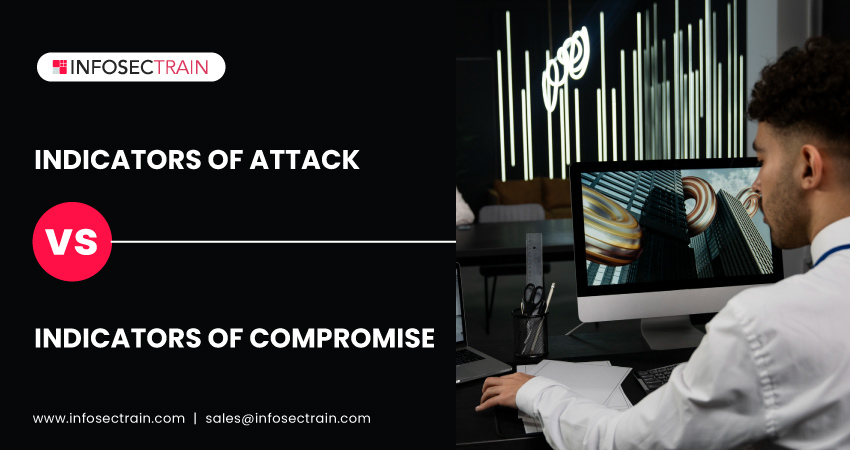IOA (Indicators of Attack) vs. IOC (Indicators of Compromise)
Security Operations Center (SOC) Analysts commonly use both Indicators of Attack (IOAs) and Indicators of Compromise (IOCs) in their day-to-day work to identify and respond to security threats more promptly and effectively. They provide different perspectives on the threat landscape and enhance the effectiveness of a SOC’s incident detection and response capabilities. Let us understand the differences between the IOAs and IOCs.

Table of Contents
What is IOA (Indicators of Attack)?
What is IOC (Indicators of Compromise)?
What are the Differences Between IOA and IOC?
IOA or IOC: Which is more effective?
What is IOA (Indicators of Attack)?
IOA (Indicators of Attack) are evidence-based patterns or anomalies in a system that indicate the presence or occurrence of a cyber attack or malicious activity. These indicators include unusual network traffic, unauthorized access attempts, abnormal user behavior, and other abnormal activities that can help detect and respond to ongoing or imminent cybersecurity incidents in real-time.
What is IOC (Indicators of Compromise)?
IOC (Indicators of Compromise) are artifacts or evidence that indicate a system or network has been compromised by a cyber attack. They are used to identify and investigate security incidents, allowing organizations to respond promptly and mitigate the impact of a breach.
What are the Differences Between IOA and IOC?
Indicators of Attack (IOA) and Indicators of Compromise (IOC) are valuable concepts in cybersecurity, but they differ in terms of their focus, scope, timeframe, and usage. Here are the main differences between IOAs and IOCs:
Focus: IOAs focus on the Tactics, Techniques, and Procedures (TTPs) used by attackers during an ongoing cyber attack. They help detect ongoing or imminent attacks by identifying suspicious behaviors or patterns that are indicative of malicious activity. While IOCs focus on identifying artifacts or evidence that indicate a system or network has already been compromised. They are derived from observed malicious activities and provide information to identify a successful breach.
Timeframe: IOAs are typically used during the early stages of an attack to detect and respond to ongoing threats. They help organizations identify and mitigate attacks in real-time, allowing for a proactive defense. On the other hand, IOCs are used after an attack has occurred. They are valuable for post-incident investigations and forensic analysis to determine the scope, impact, and root cause of a compromise.
Usage: IOAs are proactive in nature and help security teams identify potential threats or attacks based on known attack patterns and techniques. They focus on the behaviors and activities of attackers to detect and prevent attacks before they succeed. While IOCs are reactive in nature and are used to identify the presence of a compromise after an attack has taken place. They help organizations identify and respond to security incidents, assess the extent of the compromise, and implement remediation measures.
Scope: IOAs cover a broader range of potential attack scenarios and techniques. They use behavioral analysis, anomaly detection, and heuristics to identify potentially malicious activities. While IOCs are often based on known signatures, patterns, or artifacts associated with specific threats or compromises. They include indicators such as particular file hashes, IP addresses, URLs, or patterns associated with known malicious entities.
Examples: IOAs include unexpected login attempts, unusual network traffic, suspicious file downloads, etc.
IOCs include malware signatures, suspicious network traffic patterns, anomalous user account activity, malicious URLs or domains, etc.
In conclusion, IOAs focus on detecting and preventing attacks by identifying suspicious behaviors and activities during an ongoing attack, while IOCs are used to retrospectively identify and investigate security incidents by analyzing artifacts and evidence left behind after a compromise. Both IOAs and IOCs play crucial roles in enhancing an organization’s overall security posture and incident response capabilities.
IOA or IOC: Which is more effective?
IOAs are generally considered more effective than IOCs in cybersecurity because they allow for proactive threat detection and prevention. IOAs focus on the tactics, techniques, and procedures used by attackers. This proactive approach allows organizations to detect attacks earlier, respond swiftly, and implement necessary security measures to mitigate the impact of an ongoing attack before it leads to a compromise. In contrast, IOCs are reactive and rely on indicators left behind after a compromise, which may not always be immediately available or effective against sophisticated attacks.
How can InfosecTrain help?
Understanding and utilizing IOAs and IOCs is crucial for effective threat detection and incident response. Enroll in InfosecTrain’s SOC Analyst online training course to gain a clear understanding of the distinctions between Indicators of Attack (IOAs) and Indicators of Compromise (IOCs). You can also understand the Indicators of Compromise (IOC) from our Certified SOC Analyst (CSA) certification training program.
TRAINING CALENDAR of Upcoming Batches For SOC Analyst
| Start Date | End Date | Start - End Time | Batch Type | Training Mode | Batch Status | |
|---|---|---|---|---|---|---|
| 05-Apr-2025 | 25-May-2025 | 09:00 - 13:00 IST | Weekend | Online | [ Open ] | |
| 03-May-2025 | 22-Jun-2025 | 19:00 - 23:00 IST | Weekend | Online | [ Open ] | |
| 05-Jul-2025 | 17-Aug-2025 | 19:00 - 23:00 IST | Weekend | Online | [ Open ] |
We also provide customized SOC Expert Combo programs that help individuals gain the necessary skills and knowledge to effectively mitigate, detect, evaluate, and address cybersecurity threats and incidents.







 1800-843-7890 (India)
1800-843-7890 (India)